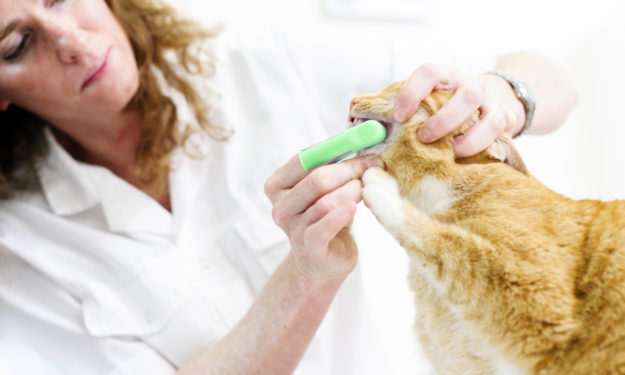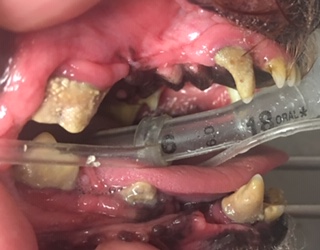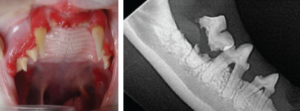Dental Diseases in Dogs and Cats

Say “Cheese!”
Many of our furry friends don’t just share our homes with us; they also sleep with us, curl up on the sofa with us, and give us kisses when we return home. This is lovely . . . unless your pet has a mouth that looks like this:

Now when they try to snuggle up to you and try to lick your face, you may cringe in horror because their breath smells like something rotten. We call this, “Garbage mouth.”
Why Does it Smell So Terrible?
Dental disease is the most common chronic disease in our dog and cat patients. It is often silent and most animals suffer without complaint. The outward signs of dental disease can range from obvious issues like reluctance to eat dry food, pawing at the mouth, or drooling to more subtle changes such as hiding, decreased playfulness, or weight loss.
Interestingly, the diseases that dogs and cats get are often different.
Canine Dental Disease
Dogs classically develop periodontal disease from the accumulation of dental calculus, as pictured above. Food, bacteria, and other debris accumulate on the surface of the teeth, gradually hardening into a cement-like material over time. This causes irritation to the gums (gingivitis), which in turn leads to gingival recession and bone loss. By the time dogs show up at our hospital with mouths like the dog pictured above, they often have such severe disease that many of their teeth are loose and must be extracted surgically.
Feline Dental Disease
Cats, on the other hand, are less commonly affected by periodontal disease from calculus. Instead, they get a variety of cat-specific disease such as resorptive lesions and stomatitis. In these diseases, the teeth and/or gums are painful and inflamed. Cats with these issues often show up with bright red gums or even teeth that are partly eaten away as shown below.

What can be done in the face of so much dental disease?
Here are a few simple things that you can do to help keep your furry friend’s teeth and gums healthy. Here’s to a lifetime of (non-stinky) kisses!
- Start brushing your cat or dog’s teeth when they are young! This is honestly much easier than it sounds. Remember to use pet toothpaste and strive for daily (although three times a week will make a big difference!). Here are some slideshows with how-to information:
- Try some of the proven treats, supplements, and food that can help to decrease the development of pet dental disease. The Veterinary Oral Health Council has links to products for dogs and cats that have been studied and shown to be effective. These are veterinary dentist recommended.
- Feed dry food instead of canned. Canned food is more likely to stick to the teeth, causing the accumulation of food material that will lead to tartar and plaque. Of course, if your pet needs canned food for a medical reason please feed them as your veterinarian recommends.
If in doubt, have your veterinarian perform a thorough oral exam. Although some pets may get lucky with excellent oral health, most pets do require dental cleanings under anesthesia periodically, sometimes starting as early as 1 year of age (usually breed specific). Having your pet’s teeth checked at their annual exam, and doing dental cleanings early enough, before serious disease and issues arise, can actually keep your pet in better health for their lives.